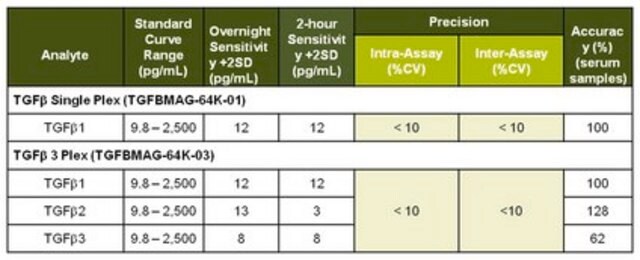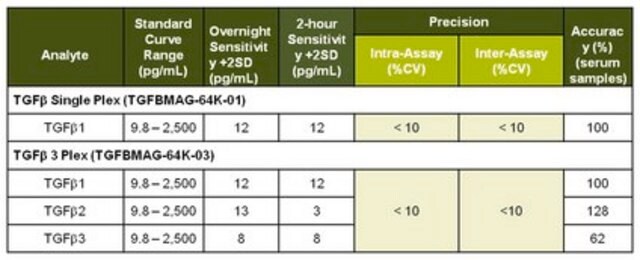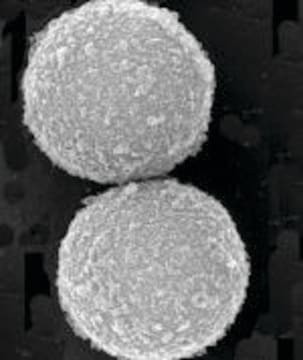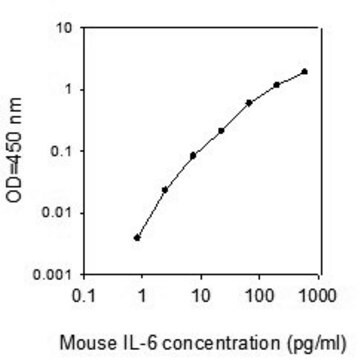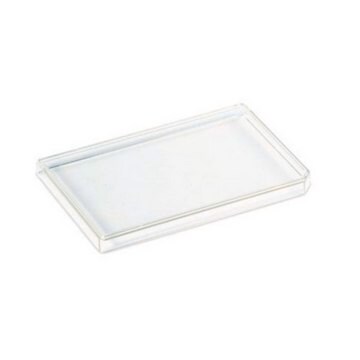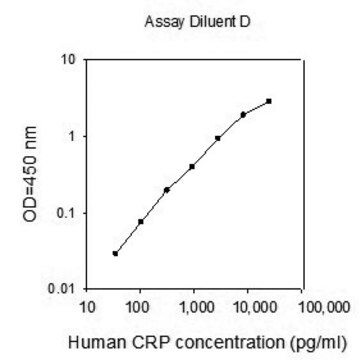TGFBMAG-64K-01BK
MILLIPLEX® TGFß1 Magnetic Bead Single Plex Kit Space Saver (Bulk) Packaging
for quantification of the TGF-β1 biomarker in the multiple species
Iniciar sesiónpara Ver la Fijación de precios por contrato y de la organización
About This Item
Código UNSPSC:
12161503
eCl@ss:
32161000
NACRES:
NA.47
Productos recomendados
Nivel de calidad
reactividad de especies
human, pig, canine, rat, nonhuman primates, mouse, feline
fabricante / nombre comercial
Milliplex®
assay range
sensitivity: 12 pg/mL
standard curve range: 9.8-2,500 pg/mL
técnicas
multiplexing: suitable
compatibilidad
configured for Single Plex
método de detección
fluorometric (Luminex xMAP)
Condiciones de envío
wet ice
Descripción general
The transforming growth factor beta (TGFβ) system, a superfamily of cytokines as well as signaling pathways, is highly conserved throughout the animal kingdom. TGFβ functions in immune cell development, angiogenesis, wound healing and embryonic development, bone development and plays a critical role in immune response, heart disease, and cancer. In its normal state TGFβ is one of the few classes of proteins able to inhibit cell growth by halting mitosis at the G1 state, inducing cell differentiation or apoptosis. However, during oncogenesis mutations in the TGFβ signaling pathway result in tumor cell resistance to the effects of normally functioning TGFβ, causing proliferation without regulation. Initial research suggests that VE-cadherin may enhance the mutated TGFβ signaling pathway.
The MILLIPLEX® TGFβ1 Single Plex Magnetic Bead Kit is a single plex kit to be used for the quantification of TGFβ in serum, plasma, tissue/cell lysate and culture supernatant
samples.
The Luminex® xMAP® platform uses a magnetic bead immunoassay format for ideal speed and sensitivity to quantitate multiple analytes simultaneously, dramatically improving productivity while conserving valuable sample volume.
Panel Type: Cytokines/Chemokines
The MILLIPLEX® TGFβ1 Single Plex Magnetic Bead Kit is a single plex kit to be used for the quantification of TGFβ in serum, plasma, tissue/cell lysate and culture supernatant
samples.
The Luminex® xMAP® platform uses a magnetic bead immunoassay format for ideal speed and sensitivity to quantitate multiple analytes simultaneously, dramatically improving productivity while conserving valuable sample volume.
Panel Type: Cytokines/Chemokines
Especificidad
In addition to human TGFβ1, the assay can detect TGFβ1 in serum of the following; horse, rabbit, mouse, rat, mini pig, canine, hamster, guinea pig, rhesus monkey and cynomolgous monkey. However, the exact amount of cross reactivity has not been determined.
Aplicación
- Analyte: TGFβ1
- Recommended Species: In addition to human TGFβ1, the assay can detect TGFβ1 in serum of the following: horse, rabbit, mouse, rat, mini pig, canine, hamster, guinea pig, rhesus monkey and cynomolgus monkey. However, the exact amount of cross reactivity has not been determined.
- Recommended Sample Type: Serum, plasma, cell/tissue culture supernatants and lysates
- NOTE: This assay requires a sample acidification treatment using the provided reagents and protocol.
- Recommended Sample Dilution: 25 μL per well of a 1:30 dilution after acidification treatment of serum and plasma samples; cell/tissue culture samples may require dilution prior to acidification treatment (see protocol for details).
- Assay Run Time: Overnight (16-18 hours) at 2-8°C or alternatively, 2 hours at room temperature (20-25°C).
- Research Category: Inflammation & Immunology
- Research Subcategory: Cardiovascular Disease, Chronic Inflammatory Disease, Immune Disorders, Inflammatory Disease, Rheumatoid Arthritis
Almacenamiento y estabilidad
Recommended storage for kit components is 2 - 8°C.
Información legal
Luminex is a registered trademark of Luminex Corp
MILLIPLEX is a registered trademark of Merck KGaA, Darmstadt, Germany
xMAP is a registered trademark of Luminex Corp
Cláusula de descargo de responsabilidad
Unless otherwise stated in our catalog or other company documentation accompanying the product(s), our products are intended for research use only and are not to be used for any other purpose, which includes but is not limited to, unauthorized commercial uses, in vitro diagnostic uses, ex vivo or in vivo therapeutic uses or any type of consumption or application to humans or animals.
Certificados de análisis (COA)
Busque Certificados de análisis (COA) introduciendo el número de lote del producto. Los números de lote se encuentran en la etiqueta del producto después de las palabras «Lot» o «Batch»
¿Ya tiene este producto?
Encuentre la documentación para los productos que ha comprado recientemente en la Biblioteca de documentos.
Nuestro equipo de científicos tiene experiencia en todas las áreas de investigación: Ciencias de la vida, Ciencia de los materiales, Síntesis química, Cromatografía, Analítica y muchas otras.
Póngase en contacto con el Servicio técnico